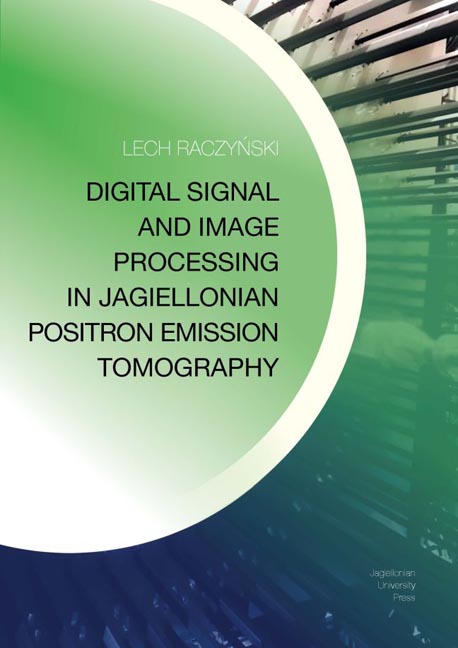Book contents
- Frontmatter
- Dedication
- Acknowledgements
- Contents
- Abbreviations
- Preface
- 1 Introduction
- 2 Positron Emission Tomography
- 3 Algorithmic background
- 4 Low-level data processing in Jagiellonian PET
- 5 High-level data processing in Jagiellonian PET
- 6 Results
- 7 Conclusions and summary
- Appendix
- References
- Miscellaneous Endmatter
- Frontmatter
- Dedication
- Acknowledgements
- Contents
- Abbreviations
- Preface
- 1 Introduction
- 2 Positron Emission Tomography
- 3 Algorithmic background
- 4 Low-level data processing in Jagiellonian PET
- 5 High-level data processing in Jagiellonian PET
- 6 Results
- 7 Conclusions and summary
- Appendix
- References
- Miscellaneous Endmatter
Summary
Positron Emission Tomography (PET) is at present one of the most technologically advanced diagnostic methods for non-invasive imaging in medicine [8,9]. It plays a unique role both in medical diagnostics and in monitoring effects of therapy, in particular in oncology, cardiology, neurology and psychiatry. In PET measurement the patient is injected with radiotracer, containing a large number of metastable atoms of positron emitting radionuclide. Since the rate of assimilation of radiopharmaceuticals depends on the type of the tissues, sections of the diseased cells can be identified with high accuracy, even if they are not yet detectable via morphological changes. Therefore, PET is extremely effective in locating and diagnosing cancer metastases.
As the result of positron annihilation, two photons travelling off with nearly opposite directions are produced. The detection system is usually arranged in layers forming a ring around the diagnosed patient. In the basic PET measurement scheme, the information about the single event of positron annihilation is collected in the form of a line joining the detected locations that passes directly through the point of annihilation, i.e. the Line-of-Response (LOR). The set of registered LORs forms the basis for PET image reconstruction. New generation of PET scanners utilizes not only information about the LORs but also takes advantage of the measurement of the time difference between the arrival of the two photons at the detectors, referred to as the Time-Of-Flight (TOF) difference [10]. State-of-the-art TOF-PET scanners use scintillation crystals and operate at a time resolution, defined hereafter as the coincidence resolving time (CRT), of the order of 300−400 ps [11, 12]. The fundamental improvement brought by TOF is an increase in signalto- noise ratio (SNR); in the first approximation the SNR improvement due to TOF application is inversely proportional to the square root of the CRT [13]. For example, if a time resolution of 400 ps is applied, this yields, for a patient of about 40 cm average transaxial size, an SNR about three times better than for non TOF information measurement. The time resolution achievable with the scintillator detectors is limited by the optical and electronic time spread caused by the detector components, and by the time distribution of photons contributing to the formation of electric signals.
- Type
- Chapter
- Information
- Publisher: Jagiellonian University PressPrint publication year: 2021



